|
At the beginning of the 18th
century the population of Walsall was just over 5,500,
almost twice what it was 100 years earlier.
In January 1701 Walsall Corporation
acquired the old manorial corn mill by The Bridge, from
the lady of the manor, Dame Elizabeth Wilbraham, on a
500 year lease, at an annual rent of two shillings. The
building was in a poor condition and the Corporation
agreed to repair it and to give any profits from
grinding to the poor. Repairs were made, and small sums
of money earned, but by 1763 the building had been
demolished or converted to other uses.
Difficult times for the
Corporation
During 18th century the
Corporation faced many problems. Its popularity was
at an all time low, there were difficulties in
recruiting members, financial crises, and
hostilities between the Borough and the Foreign.
Many of the burgesses were
tradesmen, who were not prepared to be members of
the Corporation, in case they had to make unpopular
decisions that might prejudice their business
interests. Foreigners, Nonconformists, Catholics,
and High Tories were excluded from the Corporation,
and until 1741 the Mayor received no payment for his
duties. After 1741 any mayor who served for two
consecutive years would receive a payment of £15,
from then on most mayors served a double period.
Corporation membership was lower
than ever, with rarely more than 12 members.
In the twenty years up until 1708, thirty Capital
Burgesses had been appointed to the Corporation, but
in the next twenty years only eleven were willing to
serve on the Corporation.
There were financial
difficulties, particularly over the poor rate.
People in the Borough were paying three times more
than those living in the Foreign, which led to
resentment, and the call for a general rate for
everyone in the town. In 1752, in an attempt to
overcome the problem, the magistrates appointed four
overseers for the whole town, in the hope that his
would lead to the establishment of a general rate.
Previously there had been separate overseers for the
Borough and the Foreign.
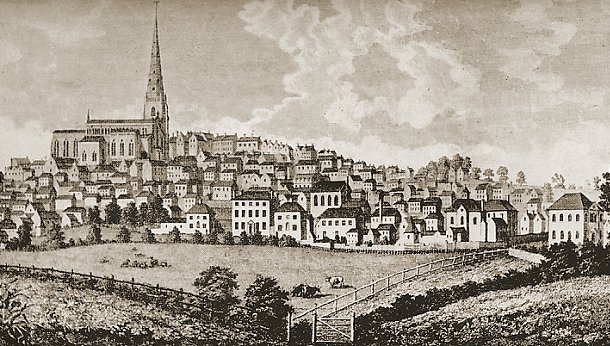
Walsall in about 1796. Stebbing Shaw.
The people in the Foreign would
have none of this, and one of the Foreign overseers,
Samuel Wilkes of Bloxwich went to prison rather than
handing his books over to the magistrates. The
leading inhabitants of Bloxwich took their case to
the Court of the King’s Bench on two occasions, each
time achieving a judgement against the magistrates.
In 1756 the magistrates finally gave-in and
reinstated the old system.
One of the Corporations’ most
serious problems was maintaining law and order.
There were a many disturbances by large disorganised
crowds, demonstrating against political parties, the
established church, Methodism, the crown, or more
usually high food prices. During one riot in 1750 an
effigy of King George II was hung on Church Hill.
In the latter half of the 18th
century many people were unemployed and could not afford
to properly feed themselves and their families. The
price of wheat had escalated, and so people took to the
streets, attacked millers, food wholesalers, and even
market traders. They believed that they could force
traders to reduce prices by rioting. Things were so bad
that in 1776 over twenty people were sworn-in as
constables to protect the market traders from rioting crowds, who
frequently attacked them, and were dissuading them
from coming to the market.
In 1780 a hundred coal miners
invaded the corn mill at Bescot, and forced the
miller to sell them wheat at five shillings a
bushel. They then marched to Walsall market and
forced the traders to do likewise.
The system of law and order was
inadequate to cope with the problem, which was made
worse by the rising population. The magistrates held
a petty session each week, and a Court of Quarter
Sessions. The town gaol was insecure and many
prisoners escaped, some being sent to Wolverhampton
for tighter security.
Relief for the poor
In 1723 poor relief legislation
was passed under the terms of the Workhouse Test Act
which stated that anyone wanting to receive poor
relief had to enter a workhouse and undertake a set
amount of work. The legislation was intended to
prevent irresponsible claims on a parish's poor
rate. By 1750 there were 600 parish workhouses in
England and Wales.
In 1717 Walsall Corporation
purchased three cottages on Church Hill, near the
church, from Mr. Thomas Harris of Worcester. By 1732
the cottages had been converted into Walsall’s first
workhouse, with accommodation for 130 people. The
first governor, Simon Cox was followed by Richard
Lambert, appointed in 1781 at a salary of £25. He
was given the following instructions, which were
recorded in the vestry book:
| That the said Richard
Lambert keep good order and rule
in the said house; that he and
the whole family go to rest and
rise at necessary and reasonable
hours; that the said house and
premises at all times be kept
clean, sweet and decent; also to
cause the seats and pews in the
said parish church to be swept
and cleaned every Saturday by
the poor in the said house,
without any expense to the
inhabitants; also that the said
governor of the said house, not
to have any private or weekly
bill for the use of the said
house or the poor, etc.;
likewise that he keep the poor
in the said house to work (such
as are not capable to go to
out-work) in such employment as
he shall think necessary and
most convenient. And those
out-workers, such as mechanics,
labourers, etc., the said master
to agree with all masters or
mistresses for such servants by
the day, the week, or piece, and
he to keep a memorandum book for
that purpose, by which means it
may be made known to the acting
overseer for the time being,
what is due from each master to
each servant, and the said
governor to collect such money
weekly, and transmit the same to
the overseer of the poor; also
the said governor to go on all
journeys on parish business or
such as are thought advisable by
the overseer or his colleague;
the said governor to pay the
poor, occasionally to assist the
overseer in buying of meat,
clothing, or other reasonable
business; the said governor to
be allowed all reasonable
charges upon journeys. It is
further agreed the said governor
shall not be allowed any other
perquisites, more than his
yearly wages of £25. |
|
In 1799 the workhouse was
enlarged to accommodate over 200 people. It had a
large dining room, 42 feet long by 15 feet wide,
with two very pleasant and airy lodging rooms above,
and a large workroom with facilities for spinning
wool and linen. The poor were expected to work there
and make their own clothes. The building was
inconveniently situated, being on top of the hill.
Water for drinking and washing had to be carried
there by hand. There was also a workhouse at
Bloxwich capable of holding around 100 people. Most
of the poor were given outdoor relief, and lived
away from the workhouse. They received payments for
rent, fuel, clothing, and medical expenses. In 1742
the expenditure for the poor amounted to
£338.17s.2½d. By 1810 this had increased to around
£2,000.
Many people insured themselves
against unemployment and sickness by joining clubs
and benefit societies. By the end of the century
there were 20 of them in the town, more than
anywhere else in Staffordshire. They had around
1,800 members, who in times of need received between
6 and 8 shillings a week, plus medical treatment.
A Municipal Cemetery and a
Racecourse
By 1750 there was almost no
space left in St. Matthew’s graveyard for burials
and so the Corporation purchased land off Bath
Street known as Windmill Field, and built what was
called the Old Burial Ground, Walsall’s first
municipal cemetery. It was surrounded by a brick
wall, the first bricks being laid at a ceremony in
March 1751 by Mr. A. Bealey, Mrs. Elizabeth Cox, and
the Rev. Robert Felton.
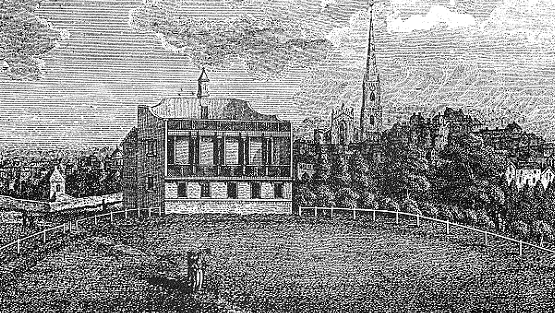
Walsall racecourse and grandstand. From Thomas
Pearce's History and Directory of Walsall.
Long Meadow in between Walsall
Brook and the mill stream was the site of the town’s
racecourse which opened in 1777. Meetings were held
annually during the Michaelmas Fair, and a
grandstand was added in 1809.
Trades in 1767
Sketchley’s Directory published
in 1767 contains the first detailed list of Walsall
trades. It listed 84 buckle makers, 66 chape makers,
38 publicans, 19 spur and rowel makers, 13 snaffle
makers, 10 ironmongers, 8 stirrup makers, 7 chapmen
and merchants, and several awl-blade makers,
blacksmiths, chandlers, curriers, fellmongers,
gunsmiths, locksmiths, nailers, skinners, tanners,
and whitesmiths.
Inns and Hostelries
In 1774 the owner of the New
Inn on the left-hand side of Park Street (looking
towards Town End) was looking for a new tenant. The
pub was described in Aris’s Birmingham Gazette on
the 19th of September, 1774 as follows:
| To be let and entered
upon at Christmas next, all
that new erected and compleat
inn in Walsall, in the
County of Stafford, called
the New Inn, standing near
The Bridge and New Road, and
conveniently situated for
the reception of noblemen
and gentlemen travelling
through Walsall. The
business of the said inn is
daily increasing on account
of the turnpike roads being
made exceeding good from
Walsall to Birmingham,
Wolverhampton, Lichfield,
and Castle Bromwich, and
also from Walsall to a place
called Church Bridge upon
the Chester Road. The reason
Mr. Hart, the present
occupier leaves the said inn
is on account of his having
taken the Swan Inn in
Birmingham to which place
Mr. Hart goes on Christmas
next. The New Inn is
genteelly fitted up and the
bedding and furniture are
mostly new and very good,
which with the chaises and
horses will be sold to any
person inclined to take the
inn at a fair appraisement,
and great encouragement will
be given to a good tenant. |
|
Behind the inn was a well known
cock pit used for the sport of cock fighting. The
sport was very popular during the 18th century,
especially during race meetings. Higher up Park
Street, on the other side was Hancox and Clibury’s
Bell Foundry at Pott House. In 1634 they cast the
great bell for St. Mary’s Church in Lichfield. By
the latter half of the 18th century, Park Street had
become one of the most important streets in the
town, which resulted in it being paved in 1776.
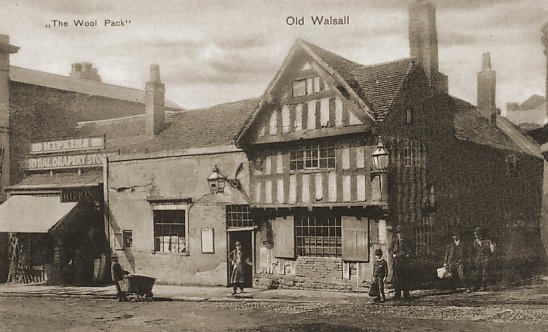
The Woolpack Inn. From an old postcard.
Other local pubs included the
Angel in Park Street, the Woolpack, and the Talbot,
both in Digbeth, the Three Swans in Peal Street, and
the Bull’s Head in Upper Rushall Street. The
Woolpack, a timber-framed building dating from the
15th century, was originally one of the finest
houses in the town. By the 17th century it had been
divided into an inn and a shop. The inn greatly
prospered because of its central position, and
became one of the main centres for cock fighting. It
survived until February 1964 when the area was
redeveloped.
The Green Dragon Inn in High
Street had been an inn since around 1707 and became
the centre of the town's social, and political life,
due to its close proximity to the Guildhall. It had
as large bowling green, 55 yards long, and assembly
rooms which were used as the town's first theatre
from around 1787 until 1803.
Improvements and Industrial
Uncertainty
By this time more traffic was
coming into the busy town centre. In order to
improve access from Birmingham Road, Bridge Street
(originally called New Street) was constructed in
1776. Until this time, all traffic to Birmingham had
to go through Digbeth and High Street to the top of
the town, and through Rushall Street. This was
treacherous, if not impossible in the winter
months, due to snow and ice.
Market house at the top of
High Street, built around 1589 was demolished in
1800. By the 1760s its position in the centre of the
road, close to the turning into Rushall Street, made
it an obstruction to traffic. It was replaced in
1809 by a smaller house further up the hill, near to
the church steps. By the 1830s it was little used,
and became a store for market stalls. It was
demolished in 1852.
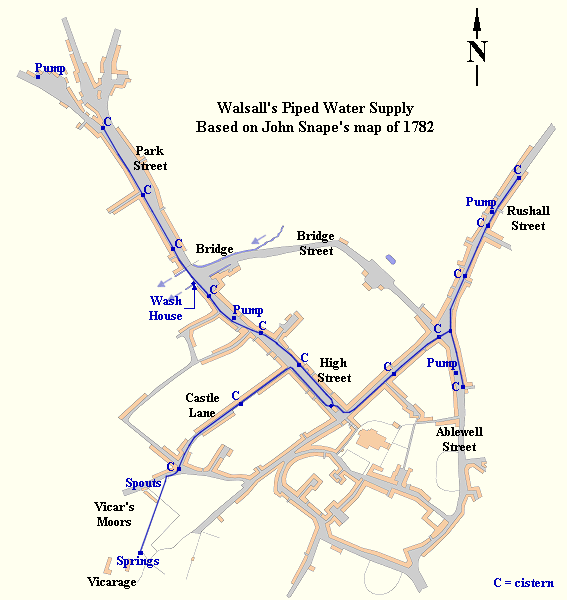
In 1778 the Corporation added
extra pumps to the piped water supply that had been
in use since 1676. The new pumps were in Ablewell
Street, and Hill Top. There were pumps in each of
the main streets, and a wash house on The Bridge,
fed by lead water pipes from the source of the
supply at Caldmore, known as the ‘Spouts’. A workman
was paid an annual allowance of 10s.6d. to keep the
pumps in good repair.
By the latter part of the 18th
century the main industries in the town were chape
making, and buckle making. In 1792 it looked as
though buckle making would soon come to and end,
because buckles were rapidly going out of fashion,
due to the use of shoe laces, then known as
shoestrings. The Walsall buckle makers sent a
deputation to London, who were introduced to King
George III by prominent parliamentarian, Richard
Brinsley Sheridan, member of parliament for
Stafford. The King was sympathetic to their cause
and told the principal officers of his court that
they must continue to use buckles instead of
shoestrings. Other members of the royal family did
the same, and the deputation, which included buckle
makers from Wolverhampton, Birmingham, and London,
invited the chief members of the royal household to
a splendid dinner to celebrate their success. In
reality they were just delaying the inevitable. By
1820 the King and his household had ceased to wear
buckles, and a local newspaper announced that
“Walsall was ruined.”
The
George Hotel, Volunteers, and Increasing Population
The George Hotel opened in
1781. It was built by Thomas Fletcher who had
previously been landlord of the Green Dragon in
High Street. It became the most important coaching
inn in the town. At the height of the coaching era
it could stable 106 horses. Many coaches stopped
there daily, and many distinguished people stayed at
the hotel. Thomas Fletcher actively campaigned for
local roads to be improved, and helped to encourage
the series of Road Improvement Acts that were passed
by parliament in the late 18th and early 19th
centuries. He continued as proprietor of the hotel
until his death in 1811, when he was succeeded by
his son, Richard. In later times the hotel was
greatly enlarged and modified.
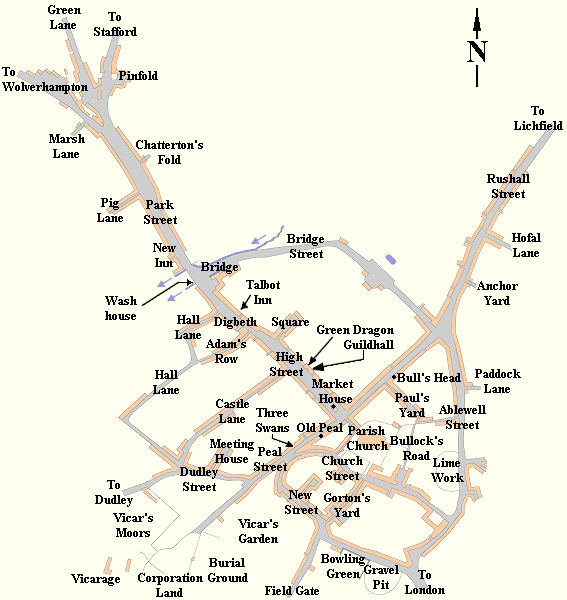
Walsall town centre in 1782.
Based on John Snape's map.
Walsall Volunteer Association
was formed in 1798 at a time when France was
threatening to invade the country. People from all
over the country were volunteering for the British
army, and Walsall was determined not to be left out.
A public subscription raised the necessary funds,
and a meeting was held in the Guildhall on May 12th,
1798, during which a letter from the Marquis of
Stafford was read. Forty three of the men who
attended the meeting joined the volunteers, who were
led by Joseph Scott, their captain. The colours were
presented at a ceremony held at Barr Beacon on
September 23rd, 1799. Afterwards the officers and
men were entertained at the George Hotel by the
Corporation, at a cost of 100 guineas.
Another association, the
Queen’s Own Royal Yeomanry, formed on July 4th,
1794, included a troop from Walsall, under the
command of William Tennant. In September 1800 the
Walsall troop, under the command of Sir Nigel
Gresley, helped to suppress riots at Walsall and
Wolverhampton caused by the high price of corn.
By 1801 the population had
grown to 10,399, divided almost equally between the
Borough and the Foreign (5,177 people lived in the
Borough, and 5,222 lived in the Foreign). The
Borough contained 1,013 houses, 135 of which were
uninhabited. There were 941 houses in the Foreign,
only 50 of which were uninhabited. There were more
women than men living in the Borough, and more men
than women in the Foreign.
Since the beginning of the
century the population had almost doubled, as it did
in the previous century, and Walsall had grown into
a sizeable Staffordshire town. The rate of
population growth hadn’t changed for two hundred
years, but in the next century things would be very
different as people flocked to the area to find
employment in the new industries that soon appeared.
By the middle of the next century there would be
around 30,000 people living in the town. |